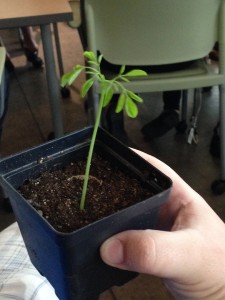Permaculture is a sustainable way to grow food. With sustainability in mind, people interested in permaculture think about getting the biggest bang for their buck. The key is to figure out multiple functions for everything, including back up redundancies.
One of the cornerstones of permaculture is to take care of the Earth by conserving soil and water. One way to conserve both soil and water is by making modifications to the surface of the Earth that work with its natural contours. The most common way to do both is to build a series of flat-bottom swales to stop the flow of water to recharge the ground water. Adjacent to a swale is a raised mound, which benefits from irrigation supplied by the swale.
As the name implies, a “forest” calls to mind a variety of plants. So in a food forest, a variety of plants grow together in an area. This is a rethinking of the “modern” monoculture way that food crops are grown. If only one type of plant is grown in an area, then the soil is depleted after a while. If a variety of plants are grown, the soil can maintain its richness. Of course this takes planning. Interactive diversity, planting a variety of perennials and annuals, allows for the maximum productivity for the minimum amount of work. To boost crop productivity, people can do a little more maintenance.
The type of soil, amount of sunshine, average temperature, and amount of rainfall must also be taken into account. Additionally, chickens play a role in preparing a permaculture area. Chicken scratching helps aerate the soil. Chickens pick out the seeds and mix in their manure.
Weeds repair the land since weeds are symptoms, not the problem. If there are soil deficiencies, then weeds will recover nutrients. Weed roots gather nutrients from the surrounding area, making them available for other plants.
After watching the highlights of a video about permaculture, where all the examples showed much larger areas than my sister’s back yard, I asked about what could be done on a smaller scale. The speaker told me that a moat could be dug around the garden. My follow up question concerned squirrel prevention. Everyone laughed, but I got a couple of good suggestions. The first was to plant “squirrel bribes,” which are things that squirrels love to eat around the garden perimeter and plant the stuff my sister’s family wants in the middle. Another suggestion was to put a mesh fence enclosing around the garden.
Toward the end of the meeting, an audience member announced he’d brought saplings of the miracle plant, moringa. Unbelievable! I went from never having heard of this plant two weeks ago to hearing about it for the third time at this meeting. This nutrient-dense plant is a great source of protein, among other things. The best thing, for growers in Texas, is that the moringa plant thrives in hot, desertlike conditions. I’d asked him so many questions about how to grow the plant on an apartment balcony, I felt disappointed when I drove away without one. I’d circulated around the room to talk to people, missing my opportunity to take a plant. The good thing is I have his contact information and spoke with him about presenting information about this miracle plant at the upcoming Austin Writers Roulette “Visionary Ideas” show in September.
As a matter of fact, I invited around five people from this meeting to speak at the September roulette. I feel that if more people heard about an alternative way to obtain food, then we can change the way things are done.



